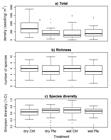Abstract
The native bracken (Pteridium arachnoideum) often occurs in mono-specific stands in the Brazilian Cerrado, and this dominance can impact on both the above-ground vegetation and soil seed bank. This study investigated how invasion by this species over a 20-year period changed the seed bank and the relationship between the seed bank and litter mass. We extracted soil samples from three replicated invaded and uninvaded sites, and followed seedling emergence for six months. We collected the above-ground biomass and litter of P. arachnoideum in ten 1m2 plots from three invaded sites. There was no difference between invaded and uninvaded areas in seed bank richness, diversity or overall abundance. The most abundant family was the Melastomataceae, followed by the Poaceae. The Melastomataceae was more abundant in uninvaded sites, but the most common species of this family (Tibouchinastenocarpa) was not affected. The grasses were more common in invaded sites in the rainy season and were affected by heterogeneity in the litter layer. The seed bank could play a role in the recovery of these invaded areas, but the presence of weeds and invasive grasses could constrain their use as a management strategy.
Keywords:
bracken; Melastomataceae; litter; savanna; biological invasion

 Thumbnail
Thumbnail
 Thumbnail
Thumbnail
 Thumbnail
Thumbnail


